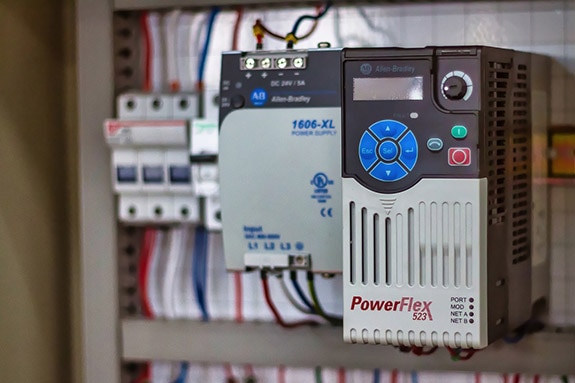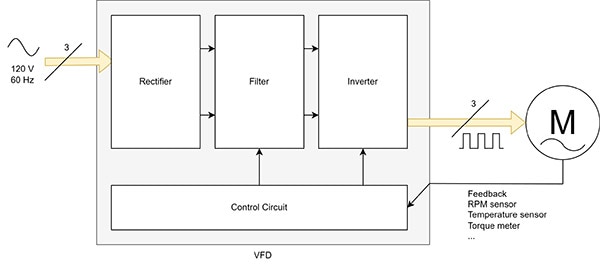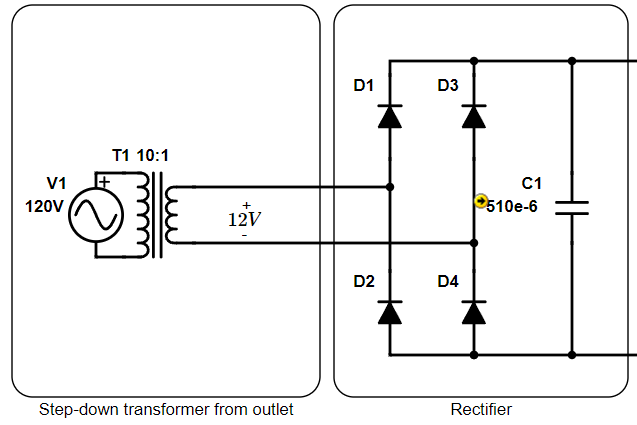What is a Variable Frequency Drive, and How Does it Work?
2023-12-18 | By Maker.io Staff
 Image Source: https://pixabay.com/photos/drive-electrical-industry-plc-5079720/
Image Source: https://pixabay.com/photos/drive-electrical-industry-plc-5079720/
You may have some experience experimenting and working with DC motors and might know that tweaking the motor’s RPM or changing its direction is typically easy to achieve. For more complex applications, you can employ driver modules and simple circuits, for example, an H-bridge. However, AC motors behave a bit differently, and this article introduces you to the basic terms associated with them and how a variable frequency drive (VFD) can help you control AC motors efficiently and precisely.
Understanding AC Motors
Without going into too much detail about the internal structure of AC motors, these motors have a specific winding configuration that determines their operation. The two most common types of AC motor winding configurations are single-phase winding and three-phase winding. While single-phase AC motors are common in smaller applications such as household appliances, three-phase motors are typically in use in HVAC systems, industrial applications, and other larger systems.
In addition to the winding configuration, you must know about the number of poles, which refers to the number of magnetic poles on an AC motor’s rotor. The poles affect the motor’s speed and torque characteristics, and a lower number of poles generally results in a speed reduction and an increase in torque output.
The Relationship Between AC Frequency, Poles, and Motor Speed
In AC motors, the revolutions per minute (RPM) directly correspond to the number of poles and AC input wave frequency, and you can calculate the synchronous speed using the following formula:

So, assuming you are working with a four-pole, three-phase AC motor and a power supply operating at 60 Hertz, the motor will run at a theoretical speed of 1,800 RPMs. When operated at 50 Hertz, the same motor runs at a speed of 1,500 RPMs. However, the practical output will typically be slightly lower due to physical characteristics and losses such as friction and slip.
How VFDs Control AC Motor Speed
A VFD can control an AC motor’s speed by altering the supply frequency. For that purpose, VFDs take an AC supply as input. This supply source can, for example, be mains power with a frequency of 60 Hertz. In the first step, the VFD rectifies the input signal to convert it from AC to DC, which can happen using various techniques, such as diodes forming a bridge rectifier. In a subsequent step, capacitors smooth and filter the now rectified signal to create a stable DC voltage.
The stabilized DC voltage is fed into the inverter section of a VFD, which consists of fast-switching semiconductors that turn on and off rapidly to create a series of voltage pulses — this can be thought of as a simulated AC waveform. The VFD feeds this waveform into the connected motor, and the inverter circuit uses PWM to control the frequency of the generated waveform. By altering the waveform, the VFD can effectively change the frequency of the output signal and control the connected motor’s speed.
 This block diagram illustrates the most important parts of a VFD.
This block diagram illustrates the most important parts of a VFD.
In addition, VFDs often include safety mechanisms and feedback circuits to ensure safe and accurate motor operation.
Benefits and Drawbacks of VFDs
VFDs allow running AC motors at different speeds, which can help increase the motor’s efficiency in various applications by tweaking the speed and torque to match the actual load requirements. This precise level of control results in significant energy savings, as motors don’t need to run at full speed when it’s not necessary. In addition, operating the motor at limited RPMs reduces wear and tear, maintenance, and electricity costs. VFDs also allow for smoothly starting and stopping AC motors by slowly letting them reach the target RPM instead of abruptly turning a motor on or off.
However, the initial cost of utilizing a VFD is higher than choosing a motor that runs at the correct speed without an additional circuit, and adding a controller increases the overall complexity.
Summary
Conventional AC motors run at a fixed speed when supplied with power. The number of poles in the motor and the AC frequency determine the motor’s RPM. By altering the frequency, you can control the speed of an AC motor.
VFDs are special motor controllers that usually take AC mains as input, rectify the signal, smooth it, and then use PWM to generate a new AC signal for sdriving the motor. The controller can change the connected motor’s speed by altering the PWM signal.
VFDs have unique benefits, which include reduced power consumption, electricity cost, wear and tear, and maintenance. However, the initial cost of employing a VFD is higher than utilizing a standard AC motor that runs at the correct speed without an external controller.
Have questions or comments? Continue the conversation on TechForum, DigiKey's online community and technical resource.





